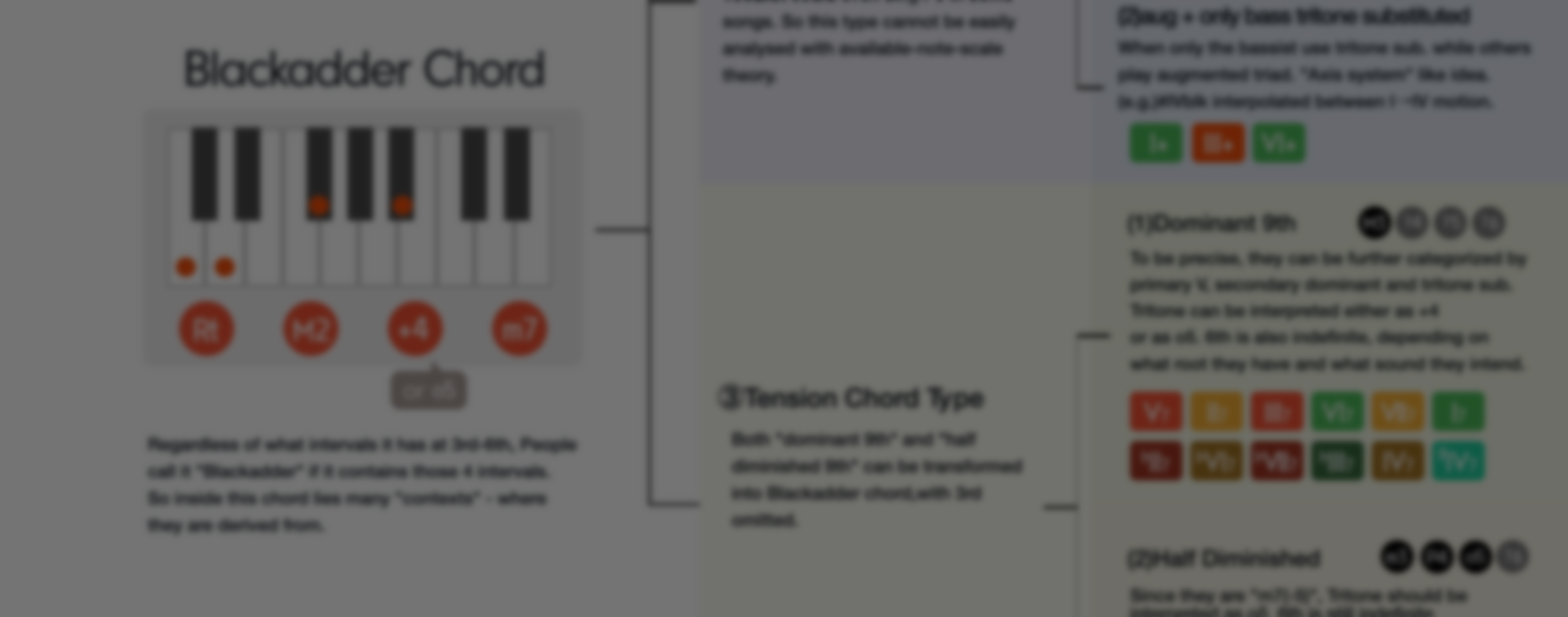Contents
1. About Blackadder Chord
“Blackadder Chord” is a strange chord found in recent J-Pop and named by Joshua Taipale on YouTube in 2017.
He initially found the same chord in 7 songs below:
1. Guilty Eyes Fever
2. Labradrite
3. CANDY LOVE
4. Rhythm to Melody no tameno Ballad
5. WANDAFUL WORLD
6. Clover♧Kakumation
7. Ohayo, Mata Ashita
And now there are many examples of this chord gathered in this spread sheet.
Chord Tones of Blackadder Chord
The Blackadder Chord (In this article I abbreviate it “Blk”) is explained as “a slash chord whose upper part is an augmented triad and the bass part is 2 semitone higher than the root of the upper aug”.
Super-dissonant sound! Really intriguing that such a monsterous chord lives peacefully in J-Pop world.
Seeing it as a stack from the bass, the upper tones are 2,6,10 semitones above it.
In the seven examples found by Joshua, chords of this formation appear on various root degrees, so as long as the formation is [0, 2, 6, 10], it is considered a Blackadder Chord regardless of the root.
Now, before introducing this chord itself, I’d like to share some basic concept on chord theory.
2. Polymorphism
We’re gonna interpret this chord, but on interpreting a chord, context is extremely crucial. What degree the bass is in the key, what the preceding and following chords are… Such information is necessary to specify the meaning of the chord.
Context and Enharmonic
For example, when you hear the term “diminished seventh chord”, what comes to mind? Many might recall the rootless voicing of a dominant ninth, but that’s just one “typical” instance, isn’t it? In reality, there are plenty of other uses, such as the vii chord in harmonic minor, variations of the subdominant minor, and the transformed tonic chord.
- Rootless Dom9 (Passing Diminished)
- VIIo7 of Harmonic Minor Key
- Subdominant Minor IVm6(+11)
- Auxiliary Tonic Diminished
They have different functions, different tendency of progression and different impression on listening.
Of course, any chord can have different roles depending on its position within the key. A C major chord serves as the dominant in the key of F and the subdominant in the key of G. However, advanced chords like dim7 are even more special. In a very strict interpretation, these have different spellings for the enharmonic interval.
♯Vo7 is a very typical instance of diminished seventh stack in a genuinly tertian manner, whereas the tonic diminished is a derivative case, and in the context of the example above, it would be better understood to consider each tone as neighbor tones resolving stepwise to mi, so, and ti, thus conceiving re♯, fa♯, and la1.
Chord tones can become odd or even depending on the context. This is something that doesn’t happen with ordinary major or minor chords.
In the Case of the Blackadder
And beware that the blackadder chord also exhibits this complexity, including enharmonic equivocality.
The X, 6 semitones, can be either +11 or o5. The Y is mostly m7 but could be +6. And the Z is almost always M2 but could theoretically be o32. None of them is certain!
Enharmonic spelling is not merely a matter of aesthetics on sheet music. The difference between odd/even degrees relates to the stability and tendency of the notes, affecting the practical use of chords.
Slashed Chord Interpretation
Another tricky aspect is that the blackadder chord is a hybrid chord. Though Joshua primarily see it as a slashed chord, it can also be described as a tension chord (with 3rd omitted).
And you cannot clearly say whether it’s major 3rd or minor 3rd that is omitted (again, context-dependent).
At first glance, it may seem that there’s little difference between interpreting it either way, much like how IIm7/V and V9sus4 are nearly indistinguishable. However, the presence of an augmented triad on the top 3 voices is actually quite significant (I’ll talk about it later).
Thus, in advanced-level chords, a single chord (in terms of semitone structure) can actually have multiple “musical” structures when observed closely. In this article, I’d like to refer to this attribute as “Polymorphism” of a chord.
General, Parental, and Abstract Entity of Blk
When it comes to chords that have been bestowed with special names, we’ve had “Mystic Chords” in Chapter V and “Tristan Chords” in Chapter VII, but the circumstances surrounding these are quite different.
The Mystic Chords originate from specific compositions by Scriabin, and the Tristan Chords are the one derived from certain Wagnerian pieces, and furthermore, they are chords explicitly notated in sheet music. So when discussing these chords, the interpretation doesn’t become excessively complicated by considerations of spellings.
Blk is different. It begins with examples from 7 songs, and the samples have since increased, yet there is no sheet music. What they have in common is just the formation [0,2,6,10].
So the term “Blackadder Chord” is actually a collective term that brings together many contexts, like a terminal where many routes converge.
Similar characteristics are also present in regular aug and dim7 chords, and the enharmonic modulation introduced in Chapter VII is a technique that utilizes this trait. However, Blk’s expansiveness is even more pronounced, making it a chord worth deep observation.
So let’s classify the specific contexts from which we can interpret Blk.

